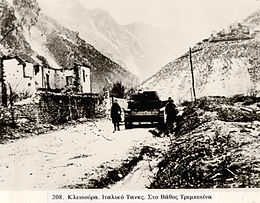Capture of Klisura Pass
| Capture of Klisura Pass | |||||||
|---|---|---|---|---|---|---|---|
| Part of the Greco-Italian War | |||||||
 Greek soldiers near a captured Italian tank |
|||||||
|
|||||||
| Belligerents | |||||||
|
|
|
||||||
| Commanders and leaders | |||||||
| Ugo Cavallero |
Alexander Papagos Dimitrios Papadopoulos |
||||||
The Capture of Klisura Pass (Greek: Κατάληψη της Κλεισούρας) was a military operation that took place during 6–11 January 1941 in southern Albania, and was one of the most important battles of the Greco-Italian War. The Italian Army, initially deployed on the Greek-Albanian border, launched a major offensive against Greece on 28 October 1940. After a two-week conflict, Greece managed to repel the invading Italians in the battles of Pindus and Elaia-Kalamas. Beginning on 9 November, the Greek forces launched a major counteroffensive and penetrated deep into Italian-held Albanian territory. The Greek operations culminated with the capture of the strategically important Klisura Pass on January 1941.
After its successful counter-attack and the Battle of Morava-Ivan, the Hellenic Army penetrated deep into Italian-held Albanian territory, taking control of the local urban centers of Gjirokastër and Korçë by December 1940. In a war council on 5 December, General Alexander Papagos, worried about the possibility of German intervention in support of the Italians, attempted to hasten the advance. Moreover, Generals Pitsikas and Tsolakoglou suggested the immediate capture of the Klisura Pass so as to secure the Greek positions.
During the period of the Greek counter-offensive, the Greek forces had much greater distances to contend with and their logistics and road network were substantially inferior compared to the Italians. The Klisura Pass was a particularly strategic location near the town of Berat and the topography of the terrain in addition to bad weather made the operation extremely difficult.
...
Wikipedia
